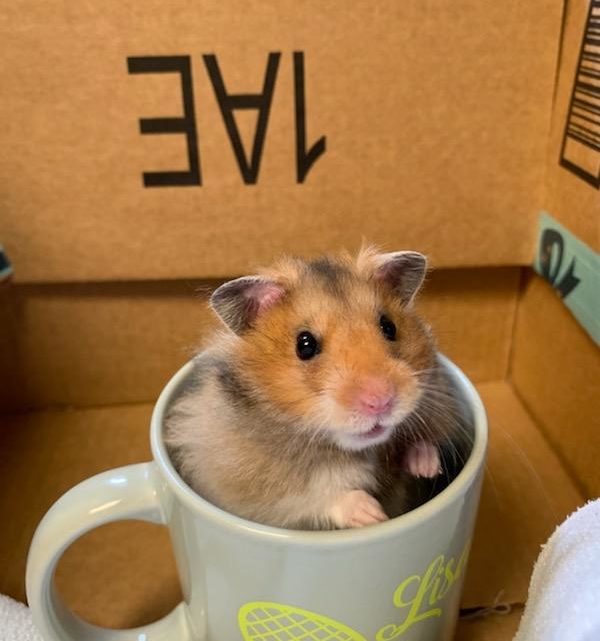Rescue Tails / Lives of the Littles
An overheard conversation between a mother and her daughter years ago has stayed with us. To this day, it highlights the kindness of those who adopt some of the most vulnerable victims of the pet trade—hamsters, mice, gerbils, and rats—the littles.
“Mom, can we please get him?” the little girl pleaded.
“Oh, honey, I don’t know. He’s already pretty old, and they don’t live very long,” the mother answered, hoping to spare her daughter unnecessary pain.
Her daughter, filled with care and concern, passionately responded, “Well then, we need to get him right away!”
Individuals with this level of compassion don’t come along every day, but they are not alone. Fortunately, there are others like them. These are the people who don’t see the littles as disposable “starter pets,” but rather as animals holding equal status to dogs and cats and being no less deserving of an enriched and comfortable life.
Hamsters are one of the most common “littles” brought to us. Typical reasons given by those who surrender a hamster are: children are no longer interested, too aggressive, not enough time to care for, or moving somewhere that doesn’t allow pets. Frequently, multiple litters are surrendered. We recently accepted a multi-generational family of 23 hamsters! These numbers are not surprising. Some hamsters begin reproducing at only 4-6 weeks old. Hamsters may already be pregnant when purchased or even sold as incorrectly sexed pairs who then, depending on the type of hamster, quickly begin either fighting (if same sex) or reproducing.
However, hamsters can become endearing companions when their needs are met. Their average lifespan, depending on the type of hamster, is 2-3 years. Quality care of hamsters involves creating the right habitat to ensure health and enrichment and also providing a high-quality diet. The most accurate information on care, diet, and housing can be found on websites specifically devoted to hamster care, such as https://erinshamsters.wixsite.
Gentle and patient handling is key to creating a friendly, trusting hamster. As small and fragile prey animals, their defenses (their sharp teeth) are always at-the-ready. This is why hamsters are not ideal for very young children.
Hamsters are nocturnal, meaning they sleep during the day and are very active at night, often running on an exercise wheel. The average distance a hamster will travel on a wheel at night is 5.5 miles, although greater distances aren’t unusual. The sound of the wheel may keep a light-sleeper awake so housing hamsters away from sleeping areas is a good idea.
Our hamster adopters are some of our favorite people! Some are adults who just love hamsters and enjoy their companionship. We see pure delight in their eyes when they meet our hamsters. Other adopters are animal-loving parents with adolescent animal-loving children, who take great pleasure in caring for a hamster.
During our pre-adoption counseling on behalf of the littles, we advocate for large housing set-ups since most pet store cages don’t meet the minimum standards for floor space. Some of our adopters have taken that advice and run with it, building wonderful multi-level “bin cages” with tunnels connecting one to another. The young son and daughter of another family didn’t think all the brightly-colored, plastic additions provided with their purchased cage were safe for their adopted hamster, so they campaigned for an extreme-makeover. Their hamster now lives in a beautiful and more natural space, with safe chew-worthy wooden ramps, bridges, and hiding spots. The awareness and compassion of these children is inspiring! In fact, the entire family is super-sensitive to the needs of animals, and their animals always benefit. Another brother/sister team of a hamster-adopting family built an intricate cardboard maze playground for their hamster, who enjoyed the exercise and enrichment provided.
We love family participation in animal care, and we see some excellent examples of it with our hamster adopters. We got a call one night from a father who was very concerned about their hamster’s change of normal behavior, asking if we thought the hamster needed to see a vet. Another time, a father and daughter visited to look at hamsters. They were warned that hamsters are nocturnal, and when running on their wheels at night they have been known to keep people awake. The father laughed. He told us he’s a bartender and up late anyway, so the hamster would probably be his buddy at night after work. We are privileged to meet such kind-hearted people!
Currently, we have hamsters available for adoption at both our Key West and Marathon campuses. You can learn more about the littles or apply to adopt by going to https://fkspca.org/adopt/




No Comment